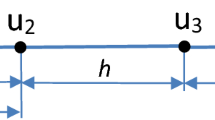Abstract
Built on the integral formulas in Part I, numerical methods are developed for computing velocity potential and streamfunction in a limited domain. When there is no inner boundary (around a data hole) inside the domain, the total solution is the sum of the internally and externally induced parts. For the internally induced part, three numerical schemes (grid-staggering, local-nesting and piecewise continuous integration) are designed to deal with the singularity of the Green’s function encountered in numerical calculations.
For the externally induced part, by setting the velocity potential (or streamfunction) component to zero, the other component of the solution can be computed in two ways: (1) Solve for the density function from its boundary integral equation and then construct the solution from the boundary integral of the density function. (2) Use the Cauchy integral to construct the solution directly. The boundary integral can be discretized on a uniform grid along the boundary. By using local-nesting (or piecewise continuous integration), the scheme is refined to enhance the discretization accuracy of the boundary integral around each corner point (or along the entire boundary).
When the domain is not free of data holes, the total solution contains a data-hole-induced part, and the Cauchy integral method is extended to construct the externally induced solution with irregular external and internal boundaries. An automated algorithm is designed to facilitate the integrations along the irregular external and internal boundaries. Numerical experiments are performed to evaluate the accuracy and efficiency of each scheme relative to others.
Similar content being viewed by others
References
Bijlsma, S. J., L. M. Hafkensheid, and P. Lynch, 1986: Computation of the streamfunction and velocity potential and reconstruction of the wind field. Mon. Wea. Rev., 114, 1547–1551.
Chen, Q. S., and Y. H. Kuo, 1992a: A harmonic-sine series expansion and its application to the partitioning and reconstruction problem in a limited area. Mon. Wea. Rev., 120, 91–112.
Chen, Q. S., and Y. H. Kuo, 1992b: A consistency condition for the wind field reconstruction in a limited area and a harmonic-cosine series expansion. Mon. Wea. Rev., 120, 2653–2670.
Davies-Jones, R., 1988: On the formulation of surface geostrophic streamfunction. Mon. Wea. Rev., 116, 1824–1826.
Golub, G. H., and C. F. Van Loan, 1983: Matrix Computations. Johns Hopkins University Press, Baltimore, 476pp.
Hawkins, H. F., and S. l. Rosenthal, 1965: On the computation of stream functions from the wind field. Mon. Wea. Rev., 93, 245–252.
Li, Z., Y. Chao, and J. C. McWilliams, 2006: Computation of the streamfunction and velocity potential for limited and irregular domains. Mon. Wea. Rev., 134, 3384–3394.
Lynch, P., 1988: Deducing the wind from vorticity and divergence. Mon. Wea. Rev., 116, 86–93.
Lynch, P., 1989: Partitioning the wind in a limited domain. Mon. Wea. Rev., 117, 1492–1500.
Sangster, W. E., 1960: A method of representing the horizontal pressure force without reduction of station pressure to sea level. J. Meteor., 17, 166–176.
Shukla, J., and K. R. Saha, 1974: Computation of nondivergent streamfunction and irrotational velocity potential velocity from the observed winds. Mon. Wea. Rev., 102, 419–425.
Xu, Q., J. Cao, and S. Gao, 2011: Computing streamfunction and velocity potential in a limited domain of arbitrary shape. Part I: Theory and integral formulae. Adv. Atmos. Sci., doi: 10.1007/s00376-011-0186-4. (in press)
Author information
Authors and Affiliations
Corresponding author
Rights and permissions
About this article
Cite this article
Cao, J., Xu, Q. Computing streamfunction and velocity potential in a limited domain of arbitrary shape. Part II: Numerical methods and test experiments. Adv. Atmos. Sci. 28, 1445–1458 (2011). https://doi.org/10.1007/s00376-011-0186-5
Received:
Revised:
Published:
Issue Date:
DOI: https://doi.org/10.1007/s00376-011-0186-5




